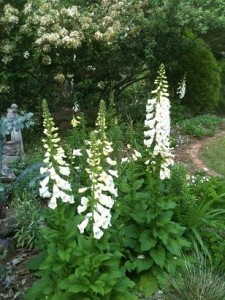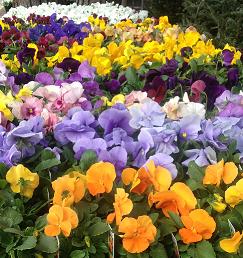We’re so lucky in Birmingham to be able to plan and plant our winter and early spring gardens in the fall, using fresh annuals, like the colorful pansies and violas, as well as various vegetables – ornamental and edible kale, cabbage, and pac choi are just a few. With summer’s heat behind us, time spent in the garden is a pleasure, not a chore.

Soon all the tables in the nursery will be laden with plants of all kinds – this is such a great opportunity for you to create the most beautiful early spring garden!
 Start with pansies and violas for beds and planters, then add supporting players. Some of the prettiest additions to your winter/early spring garden are foxglove with their tall spires of white, pink and purple, snapdragons – they are worth waiting for – poppies, with their bright orange, yellow, red and white papery blooms, and the bluest blue bachelor buttons.
Start with pansies and violas for beds and planters, then add supporting players. Some of the prettiest additions to your winter/early spring garden are foxglove with their tall spires of white, pink and purple, snapdragons – they are worth waiting for – poppies, with their bright orange, yellow, red and white papery blooms, and the bluest blue bachelor buttons.
There are so many leafy greens to interplant in containers and beds too – colorful chard, kale and mustard are so beautiful and edible as well. Curly parsley is another staple of the winter garden, adding its rich green leaves and texture to any composition.
Finally, don’t overlook the unassuming fall bulbs. Planting a bulb is a leap of faith for some, while other folks plant a few every year to add to their spring display. It’s truly amazing that such beauty lies in something so seemingly drab.
Smart gardeners know to look for all of these in the fall, planting them in anticipation of a gorgeous spring display!
Fall Planting Tips To Create A Great Spring Garden:
-
Amend your soil. You might think since you followed our advice and added soil conditioner, PlantTone, cow manure or compost to your beds last spring you’re done. Not so fast! High temperatures break down soil amendments quickly, and plants take up nutrients. Continue adding to your soil every season. Healthy, loose soils create healthy plants. (Instead of putting fallen leaves to the curb, start a compost pile with them, or run over them with your lawn mower and throw them in your beds. They’ll decompose and add to your soil’s structure and health.)
- After you get your plants home, be sure to keep them watered, especially if you can’t plant them right away. We water small transplants in 4″ pots and cell packs at least once a day, especially if it’s hot and sunny. Of course, less water is required in cloudy, cool conditions. Right before you plant them, be sure they’re moist.
- Early in the season while the soil is still warm, you can still plant with Osmocote. However, later in the winter months, use Calcium Nitrate to feed your plants, especially if the foliage of your pansies turns a reddish color. Remember, you’re planting for spring color, though on warm days through the winter you should also have some blooms.
- Water your bed thoroughly after planting, and keep it watered while your transplants are getting their feet settled in their new home. Take care not to overwater, though, especially as the temperatures cool down going into the winter months.
- Mulch your beds with shredded mulch or pine straw to keep soil temperature around the roots as warm as possible.
- Deadhead your pansies and violas! I can’t stress enough how important this is. A pansy that you leave a dead bloom on will form a seed there, instead of putting that energy into more flowers. Make a practice to walk through your garden at least once a week, taking a good look at your plants and deadheading faded blooms. If you’ve missed some, you’ll see the seed pod beginning to form. Pinch any and all off! This will go a long way toward keeping your pansies happy!
– Posted using BlogPress from my iPhone



